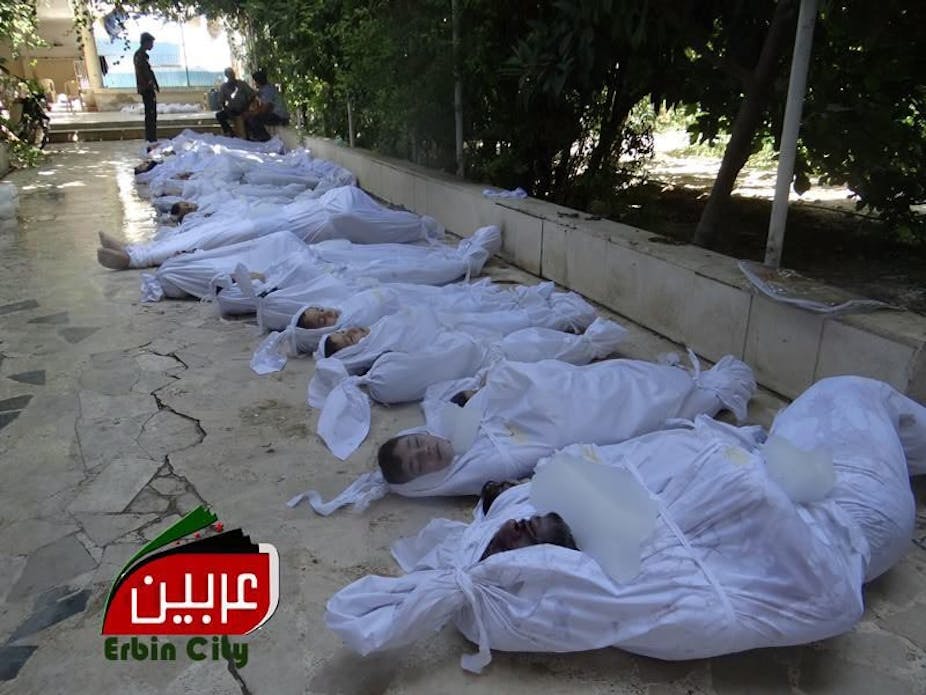Horrifying photographs and videos emerged yesterday from what appears to have been a chemical attack on thousands of civilians in Syria. It is still unclear who committed the atrocity, with both Syrian rebels and the Assad regime making the other side responsible.
What is not in dispute, however, is that at least hundreds, perhaps more than 1300 people have died, many of them children.
Some of the imagery coming out of Syria yesterday was quite harrowing.
The News Corp website news.com.au decided to run the story very prominently with numerous graphic images, as did other media outlets later in the day, including the ABC.
News.com.au editor Luke McIlveen wrote that he did not take the decision to publish the images lightly.
“But as the editor, I don’t resile from it either,” he wrote. “The more such images are censored, the less reason there is for the world to sit up and pay attention to the horror show which is playing out in Syria daily.” McIlveen also gave readers a choice:
If you feel you don’t need to look at the pictures, please don’t click on the gallery marked with a warning.
We don’t know how many readers ended up looking at the photographs, but journalists often worry about upsetting their audiences, who, it is largely assumed, do not want to be exposed to graphic images.
Traditionally, newspaper editors have called this the “breakfast test”: the idea being that readers do not want to be confronted with graphic images while enjoying their porridge. Similarly, on television, there is the so-called dinner test.
In an age of online media, however, there is increasing choice for audiences, as demonstrated by McIlveen’s decision to allow readers to decide for themselves.
However, we are still too removed from the suffering of others because of our news media’s general tendency to censor graphic images. And rather than allowing audiences to make the decision for themselves, they should be made to see the atrocity that has occurred in Syria.
Despite regular claims that our news media are becoming ever more sensationalist and intrusive in their coverage of human suffering, graphic vision of death and dying is actually still extremely rare.
A number of studies have consistently shown that only a minute percentage of news images actually show any dead bodies. And when they do, most of the images only show covered bodies, exposing us to a heavily censored version of wars. Apart from matters of taste, there is a fear of compassion fatigue, described by British sociologist Keith Tester as a process of:
…becoming so used to the spectacle of dreadful events, misery or suffering that we stop noticing them.
Some have come to see a “surfeit” of photography in modern news media, arguing that images of death are omnipresent – a claim which the vast majority of empirical studies disproves.
Another academic, David Campbell, has pointed out that while the generic quality of some photographs of suffering does have the potential to diminish the horror of an event, it is still important to see more images to prevent us from being blind to such atrocities.
Even the famous American academic Susan Sontag, who in the 1970s had lamented what she saw as a glut of graphic imagery that led to compassion fatigue, later changed her mind. In her 2003 book, Regarding the Pain of Others, she said that images of suffering were still important to display in the media, as only through them could wars become real for audiences.
Photos of the dead in Syria may not be what we want to see, but it is what we must see. It is a rare glimpse into the generally heavily censored imagery of war. Without being exposed to images of such unimaginable atrocity, regardless of who committed it in the end, we will deny the realities of the civil war that is tearing apart the people in that country.
It is only through being exposed to such images that there is at least a chance that we can actually show compassion, and display enough public outrage that can put pressure on our governments to act to help end this war.

